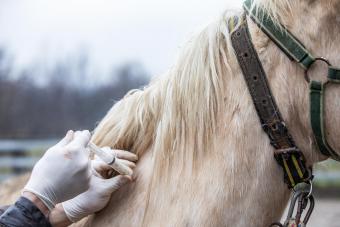
Mastitis is a serious condition that affects lactating mares, either while they are actively nursing or, most commonly, during the "drying out" period while weaning their foal. The mammary gland becomes inflamed and infected, leading to severe pain. Fortunately, mastitis in horses is easily treatable with early intervention. Home treatment consists of hand milking, cold and hot compresses, appropriate antibiotics, and anti-inflammatory pain medications.
Causes of Mastitis in Horses
Mastitis is udder inflammation and infection caused by bacteria or fungus, most commonly staphylococci and streptococci bacteria. Mastitis occurs when bacteria enter the udder.
- This is most common when the mare lies down on dirty bedding, and bacteria gain access via the teat.
- Wounds or trauma to the udder by the foal can also provide an entry point.
- In some cases, the mastitis occurs spontaneously or for no apparent cause.
Mares have two udders, but they usually develop mastitis on only one side. In rare cases, they may experience the condition in both udders. It's likely a horse will only experience mastitis once in their lifetime. Only a small number develop mastitis a second time.
Risk Factors for Mastitis
Some mares are more susceptible to mastitis. These include horses with high estrogen levels, which leads to enlarged mammary glands. Overweight mares and those with tumors on their pituitary glands are also more prone to developing it. Finally, most cases involve mares within one to two months of weaning a foal.
Common Signs and Symptoms
Early identification is the best way to keep a mare comfortable and ensure the best prognosis. Monitor for the following early signs of mastitis:
- Restlessness due to discomfort
- Going off feed
- Resentment at having the udder handled
- Kicking out at a nursing foal
- Foal appears hungry
As the infection worsens, you will notice more obvious signs:
- Fever
- Lethargy or depression
- Decreased or no appetite
- Swollen udder on one side
- Severe pain when the udder is handled
- Udder may be hot to the touch
- Abnormal milk color
- Edema of the abdomen in front of the udders
- Walking stiffly or standing with hind legs apart
When milked, mares with mastitis produce a clear fluid with white or grayish lumps. Without prompt treatment, mares may develop abscesses on the udders, or the mammary tissue may die. In extreme cases, mastitis can lead to death.
Considerations for Nursing Foals

If the mare is still nursing when diagnosed with mastitis, theoretically, the foal can still feed on the unaffected side. However, mastitis is a painful condition, and she may not allow the foal access to the sore mammary area. Take this into account and check that the foal is getting enough nutrition. This may involve hand-rearing the foal until the mastitis has resolved.
Promptly Call the Vet
Mastitis is a serious medical condition, and mares need early veterinary intervention to make a full recovery. In the early stages, you can apply a warm poultice to the affected udder to help draw out the infection if the mare will tolerate it. However, the area is likely to be sore and painful, and the mare may lash out and refuse to cooperate.
Call the veterinarian immediately if the mare's udders are enlarged, swollen, leaking pus, or developing lesions, or if she has a fever over 101.5 degrees Fahrenheit without other symptoms. If you are suspicious of mastitis, apply a heat pack and then hand-strip the udder. Repeat this several times a day to try to milk out the infection. Veterinary attention is essential if the udder is painful to the touch.
Expect a vet to palpate the mare's udders and strip milk to relieve pressure. Some may perform an ultrasound. A culture of the udder fluid will help them determine the most effective treatment based on the type of bacteria or fungi present. Because mares' anatomies make udders difficult to reach, this process is easier if mares have previously had their udders handled.
Treatment for Mastitis

Mastitis is a very treatable condition, and most mares make a full recovery without lingering effects.
- Frequent hand milking to remove fluid buildup and inflammatory cells, massage, and alternating hot and cold packs will help to relieve the uncomfortable symptoms.
- If the mare tolerates nursing, you can encourage the foal to nurse on the healthy teat. However, you may need to bottle or hand feed nursing foals until the mastitis resolves.
- Your vet may prescribe systemic antibiotics or instill mastitis tubes -- a tube containing antibiotics that are traditionally designed for use in cattle but can be used in mares with mastitis -- into the affected teat.
- Nonsteroidal anti-inflammatory medications will reduce fever, pain, and swelling in the udder.
- Mare owners can infuse commercial mastitis preparations marketed for cows safely on their mares.
- Keeping a mare's udders clean is important during treatment and is also the best way to prevent mastitis. Dirt, sweat, and body oils accumulate between teats, so use warm water or sheath cleaning solution to gently wash the mare's udders, beginning at weanling age.
Helping Your Mare Through Mastitis
With early veterinary intervention, mares often recover from mastitis within a week of beginning treatment. If your mare is lactating or weaning their foal, watch carefully to prevent this painful infection. Keep her enclosure and udder areas clean to avoid bacteria. If you do note early signs of infection, prompt intervention with intentional treatment will help her recover quickly.







